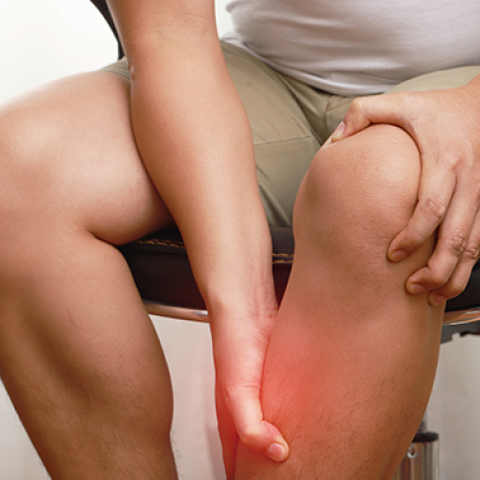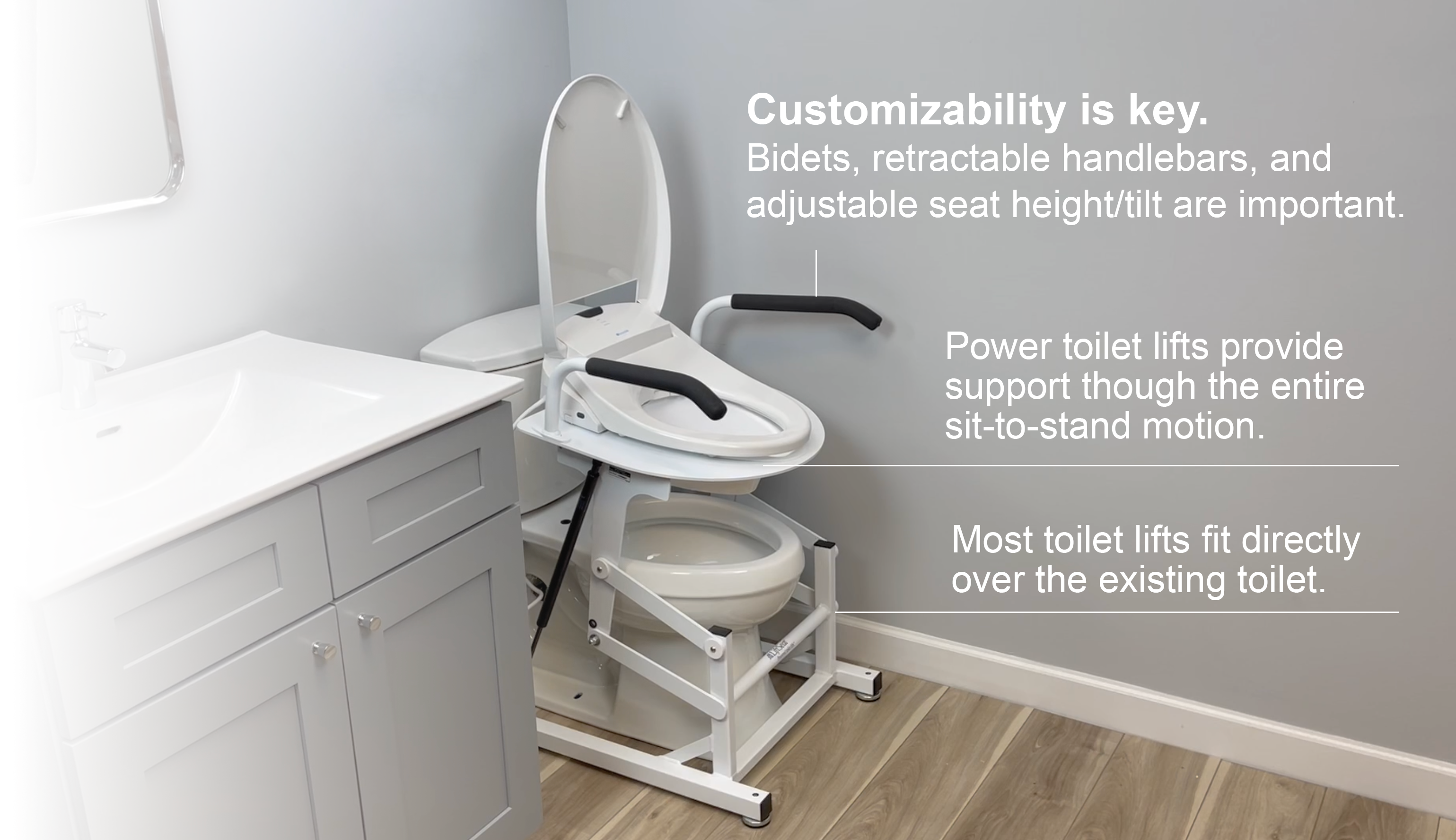Maximizing Bathroom Independence Living with Myositis - Why a Toilet Lift Makes Sense
06/01/2023
For most people, using a toilet isn’t something you think twice about. However, when living with a progressive neuromuscular disease like myositis, performing this basic function requires planning.
Using a standard toilet when you have lower body weakness can be challenging and even dangerous – with falls being a major concern. The quadriceps, one of the primary muscles used when getting on and off the toilet, is also one of the first to be impacted by myostis, with quadriceps weakness being a primary reason people see a doctor before being diagnosed.1 Therefore, many people living with myositis need to make modifications to use the toilet safely and comfortably. Of all the options currently available, a toilet lift is one of the best solutions – and here’s why.
Why do toilets pose a problem?
It’s not the act of using the toilet itself that poses a problem for people with lower body weakness – it’s the muscle strength and coordination required to sit down and stand up from the toilet.
A large amount of force is required to go from sitting to standing position. During this movement 3 of the biggest muscles in our body (glutes, quads, and hamstrings) are engaged to move from a sitting to standing position. As these muscles weaken, either due to age or disease, standing up (and sitting down) becomes harder.
As standing up becomes more difficult, fall risk increases. We move our bodies in different ways to compensate for diminished muscle strength, which impacts our coordination and balance. The process of standing can be so challenging, in fact, that a study from the Journal of Exercise Rehabilitation asserts that “the motion of standing up from sitting presents the highest risk of falls among the most frequently used motions in daily life.”2
One of the primary ways we use this sit-to stand motion is when getting up after using the toilet. It is not surprising, then, that many fall-related injuries happen in the bathroom. A report from the CDC found that over 600 people a day are injured in bathroom falls. Bathing and using the toilet are the 2 most frequently related activities, with the risk of toilet-related falls increasing with age.3
In the early stages of myositis, standing up may not be too difficult. As the disease progresses and lower body weakness increases, standing becomes more difficult. This is especially true for standing up from low seating surfaces like a standard-height toilet. According to the home improvement giant Lowe’s, the average toilet is somewhere between 15-16 inches high, from floor to seat.4 Compared to the average seat height of 16.3 inches for chairs around the home and in common public spaces5, the toilet is one of the lowest seating surfaces and consequently one of the most challenging to manage, meaning most people need the help of a caregiver or an assistive device to facilitate safe bathroom use at some point in their lives.
What options are available to make using the toilet easier?
Every person’s needs are different. Level of disease advancement, living situation and personal preference all have an impact on determining an appropriate solution for toileting. In every situation, regardless of individual circumstances, it is helpful to plan and choose a solution that will work both now and later, regardless of future changes in physicality.
For individuals who have moderate muscle strength, a grab bar or lifted toilet seat may be used to make sitting down and standing up from the toilet easier. These 2 options are relatively easy to install at home and work well for people who don’t require much assistance. They may also be used in conjunction with a caregiver to reduce the amount of force needed to perform toilet transfers.
These solutions, while helpful in the short term, do not provide a good long-term solution. In one study with sporadic inclusion body myositis patients, researchers found over a median 12-year span that individuals lost about 4.5% of their strength each year. They also noted that “this decline was most pronounced in the lower legs, which were also the weakest extremities.”6 So, within a few years, it often becomes impossible to use the toilet independently without more significant support.
Many living with myositis depend on a caregiver for assistance in the bathroom. Most of these caregivers are non-professional, meaning they are a family member or friend vs trained medical professionals.7 Anyone who has assisted someone that cannot bear weight knows it is not an easy task. Professional caregivers are trained on how to maneuver and assist patients to minimize strain and risk of injury to themselves, but informal caregivers receive no such training.
It is no surprise then that many caregivers report negative impacts on their own health - especially older caregivers. Family Caregiver Alliance reports “that 17% of caregivers feel their health in general has gotten worse as a result of their caregiving responsibilities”. Of those 65 years and older, 23% rate their physical strain as “high” (6% higher than reported by the 18-49 year-old age range).8
This means that many caregivers may not be able to perform physically demanding tasks such as toilet transfers. Significant strength is required to move someone between a wheelchair and a standard toilet, even with transfer aids such as benches and raised toilet seats. Many bathrooms are also small, making it difficult to comfortably execute the movements necessary to perform a transfer.
A solution that provides maximum support and independence
The best option to facilitate independent and safe use of the toilet is one that takes the physical burden of sitting and standing off both caregivers and care recipients. Power toilet lifts, which use a specially designed lifting mechanism to gently lower and raise people, do just that. These devices are made to fully support the user throughout the “sit-to-stand” process, so that even persons with significant lower body weakness can use the toilet with minimal assistance.

There are currently a few different types of toilet lifts available. Each lift has unique qualities and features available, but there a couple features to look for that are especially helpful for myositis:
- Bidet Functionality
Not every toilet lift comes with a bidet, but they are considered an essential feature for many users because they allow for hands-free cleaning. Some lifts also offer single-button bidet operation, which is useful for individuals who have limited manual dexterity.
- Retractable Handlebars
For performing toilet transfers, retractable handlebars are preferred. Many handlebars offer some level of adjustability, but being able to retract a handlebar so that it is up and out of the way is especially helpful for side transfers.
- Seat Height & Tilt
For every individual, there is an ideal seat height. For shorter individuals, seat height will need to be lower, and for taller individuals it will need to be higher. There is also an ideal amount of tilt for a seat – there needs to be enough tilt to provide adequate support, but not so much that people begin to feel like they’re slipping. Some people may also prefer a straight lift with no tilt. To accommodate these individual needs (and account for adjustments that will be need to made as needs and preferences change), look for a lift that offers the largest range of heights and tilts.
The LiftSeat Toilet Lift is a popular choice for many myositis families. Their lifts offer all of the features above and are highly customizable. Their customer service team is also highly responsive and dedicated to making sure each user gets the right product for their unique needs.
In general, the only negative thing people have to say about getting a toilet lift is that they wish they had known it was an option earlier. Johnnie, a LiftSeat user, gave his lift a 5-star rating, saying, “It works very well. Just wish I had purchased it sooner.”
A toilet lift is truly a win-win for anyone with myositis. It provides the support needed to comfortably and safely use the bathroom and gives both caregivers and recipients one less thing to struggle with each day.
References:
- Lindgren, U., Pullerits, R., Lindberg, C., & Oldfors, A. (2022). Epidemiology, Survival, and Clinical Characteristics of Inclusion Body Myositis. Annals of neurology, 92(2), 201–212. https://doi.org/10.1002/ana.26412
- Lee, S. K., & Lee, S. Y. (2016). The effects of changing angle and height of toilet seat on movements and ground reaction forces in the feet during sit-to-stand. Journal of exercise rehabilitation, 12(5), 438–441. https://doi.org/10.12965//jer.1632700.350
- Department of Health and Human Services, Stevens, J. A., Haas, E. N., & Haileyesus, T., Nonfatal Bathroom Injuries Among Persons Aged ≥15 Years --- United States, 2008 (2011). Centers for Disease Control and Prevention. Retrieved February 3, 2023, from https://www.cdc.gov/mmwr/preview/mmwrhtml/mm6022a1.htm
- Lowe’s. (n.d.). Find the Best Toilet for Your Bathroom Remodel at Lowe’s. Lowe’s. https://www.lowes.com/pl/Standard-height--Toilets-Toilets-toilet-seats-Bathroom/4294737213?refinement=4294722902
- Weiner, D. K., Long, R., Hughes, M. A., Chandler, J., & Studenski, S. (1993). When older adults face the chair-rise challenge. A study of chair height availability and height-modified chair-rise performance in the elderly. Journal of the American Geriatrics Society, 41(1), 6–10. https://doi.org/10.1111/j.1532-5415.1993.tb05939.x
- Cox, F. M., Titulaer, M. J., Sont, J. K., Wintzen, A. R., Verschuuren, J. J., & Badrising, U. A. (2011). A 12-year follow-up in sporadic inclusion body myositis: an end stage with major disabilities. Brain: a journal of neurology, 134(Pt 11), 3167–3175. https://doi.org/10.1093/brain/awr217
- Family Caregiver Alliance. (n.d.). Caregiver Statistics: Demographics. Family Caregiver Alliance. https://www.caregiver.org/resource/caregiver-statistics-demographics/
- Family Caregiver Alliance. (n.d.-b). Caregiver Statistics: Health, Technology, and Caregiving Resources. Family Caregiver Alliance. https://www.caregiver.org/resource/caregiver-statistics-health-technology-and-caregiving-resources/
This content is not intended to be a substitute for professional medical advice, diagnosis, or treatment. Always seek the advice of your physician or other qualified health provider with any questions you may have regarding a medical condition.